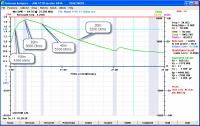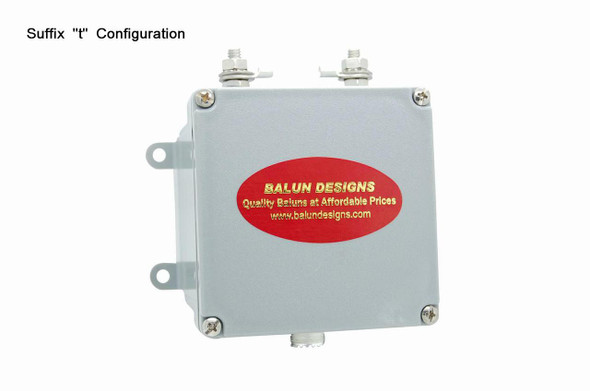Description
This Isolation balun is identical in design to the Model 1115d but with one key exception. The toroid material utilized for the two stacked cores is optimized for the lower HF bands and provides exceptional choking impedance at these frequencies. In excess of 5000 ohms choking impedance on 160m and over 6300 ohms on 80m and 40 meters. The 1116d even generates over 4000 ohms of choking impedance on 20 meters. No other design can provide this level of isolation and choking at these lower frequencies. Note that although optimized for lower frequencies, this balun also provides very good choking at higher frequencies and can be used up to 40 MHz.
N connectors and mounting options are available in "Accessories & Connectors" section of the website
"Hi Bob, the balun/choke (ed note model 1116dt) is working out great on the ZS6BKW antenna, I only need to use the tuner on 80/75 and 15 meters plus now it seems that the power company has made changes on correcting the problems with the power lines and my noise level has dropped by allot (S9+10 to S1). As a test case I can very easily get on the roof to change the balun. I tried the DX engineering one I borrowed and on 14.201 there was a plasma TV signal at S7, then I went back to your balun and the signal dropped down between S1-2 so the choking of your balun does work much better and I have been having a blast. Worked VK's on long path on 75 at gray line once this year and I only run 1Kw plus VK's and ZL's in the morning on that band when conditions are good. On 40 meters it works really good as well, worked the TX3X on SSB the first day they operated that band on that mode with maybe 3-4 calls and the other day I was on 20 meters and heard a FR4 calling CQ all by himself and nobody came back to him so I called him and he came back with a 57, I was only running 100w".
Testing shows SWR remains below 1.05 across the entire HF band, transformation is perfectly flat, return loss is between 60-80 dbmw and choking impedance is maximized at over 6k ohms on the low HF frequencies. Please click on the graphs shown below to view the complete test results.


Click to Enlarge
Tests run utilizing AIM-4170uhf Network Analyzer and a precision non-inductive 50 ohm load
***ONE EXCEPTION!***
It must be pointed out that a 1:1 balun should never be used on the second harmonic of a half-wave center-fed dipole when using coax feedline (like an 80 meter dipole being used on 40 meters). The impedance can be as great as 5,000 ohms creating very high voltages which can bring about voltage breakdown and/or excessive heating. This exception ONLY applies to coax fed HALF WAVE CENTER FED DIPOLES WHEN USING A 1:1 BALUN AT THE FEEDPOINT. This caution does not apply to fan dipoles or dipoles that utilize loading coils to create resonance on the bands in use.
Noise Reduction
While the most common advice is to improve the station's RF ground, the root of the problem is in the poor isolation of the feedline from antenna currents. If your goal is to reduce feedline radiation and improve reception by reducing noise, feedline isolation baluns are an excellent choice. Adding an additonal isolation balun at the point where the feedline exits the near field area of the antenna will substantially reduce unwanted feedline radiation and reception of EMI without the need for improved station grounding.
Specifications
| Core Material | Custom mix ferrite by Fair Rite Products optimized for low frequencies. Large 2.4 inch cores are coated and sealed for long term durability. |
| Winding Type | Stacked dual core, coaxial wound 1:1 current balun provides larger effective core area. |
| Winding Material | Mil Spec 50 ohm coax rated 19kW @ 1MHz, 9kW @ 10 MHz & 4kW @ 50 MHz. Silver flashed braid and center conductor with solid Teflon dielectric. |
| Power Rating | 1 to 31 MHz - 5kW, 10kW intermittent, 31 to 40MHz - 3kW All ratings at resonance. High SWR will reduce power handling ability. |
| Useable Frequency | 1 to 40 MHz |
| Insertion Loss | Less than .1db |
| Connectors | SO-239 connectors are gold center conductor with Teflon insulation. Studs and eyebolts are 1/4 inch. Alternate connectors and Mounting Options are available in the Accessories section. |
| Hardware | All Stainless Steel |
| Enclosure Type |
NEMA rated 4x marine grade junction box for outdoor installations. Cover utilizes integral neoprene gasket for weatherproof integrity. |
| Dimensions | 4x4x2 inches for main body of unit Dimensional Drawing of Standard Enclosure |
| Additional Info | Very high efficiency. Will not heat up or saturate at like many of the "less expensive" designs. |
Warranty Information
Noise Reduction
It is a seldom appreciated fact that feedlines which are not adequately decoupled can act as efficient vertical antennas that degrade an otherwise excellent radiation pattern. The addition of a quality feedline isolation ("choke") balun can significantly reduce feedline radiation and dramatically decrease RFI and TVI. It does this by providing the antenna with balanced current at the feedpoint and by effectively preventing the coax shield from acting as part of the antenna.
While the most common advice is to improve the station's RF ground, the root of the problem is in the poor isolation of the feedline from antenna currents. If your goal is to reduce feedline radiation and improve reception by reducing noise, feedline isolation baluns are an excellent choice. Adding an additonal isolation balun at the point where the feedline exits the near field area of the antenna will substantially reduce unwanted feedline radiation and reception of EMI without the need for improved station grounding.
If your antenna SWR is already low and you wish to reduce feedline radiation and improve reception, a feedline isolation balun is recommended. Adding one at the base of a vertical antenna will substantially reduce unwanted feedline radiation (RFI) by preventing your antenna from using the your coax feedline as a radial. This can also reduce the need for improved station grounding.
Benefits to Vertical Antennas
When quarter-wave antennas are constructed over a near perfect radial system, they have a feedpoint impedance of about 36 ohms. When they are constructed over a less than optimal radial-system there is a loss introduced into the feed system that adds to the 36-ohm figure. This improves the SWR but there is a loss in the efficiency of the antenna, signals transmitted and received have a higher take-off angle and often there is current introduced onto the feedline.
With my SteppIR vertical I use two of these baluns. One at the base of the antenna and another midway along the feedline after the near field of the antenna. You can also install the balun where it enters your shack if you would rather not break the feedline run. The balun balances the RF currents at the antenna, is terrific for keeping RF out of your operating environment and greatly reduces the noise inherent in a vertical by decoupling the feedline.
With a ground-mounted quarter-wave vertical, regardless of the radial situation, but especially with poor radial systems, there is the need for a feedline isolation balun to keep common mode currents off the feedline.
Benefits to Yagis
Yagi antennas especially, benefit from improved balanced drive and superior feedline isolation, but even simple dipoles benefit from properly selected and installed Feedline Isolation baluns. In addition, receiver noise may also be reduced by eliminating stray EMI picked up by the coax shield.
Another very useful application for a feedline isolator is installing them in series with a yagi antenna’s normal feed system. The proper location is between the antenna’s matching device/system and the feedline. Doing this will not affect the antenna and prevents the feedline from acting as part of the antenna. In beam installations, using a feedline isolator in series with the antenna’s feed system can substantially improve the antenna’s front-to-back and front-to-side ratios.

















